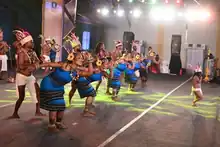Dhemsa is a traditional folk dance of tribal people of central India, Southern Odisha and adjacent areas of Chhattisgarh and Andhra Pradesh.[1] The dancers form a chain by holding each other by the shoulder and waist, then dancing to the rhythm of traditional instruments. Dhemsa is performed in groups. Its interest comes from its distinct style of composition, rhythm, body language, traditional costumes, hairstyles, and choreography.
Description
Traditional folk instruments that are used in this dance are dhol, tamak', changu and mahuri. A Dhol is equivalent to a bass drum, and a Tamak' is an instrument like a bongo which is used to maintain the tempo of the rhythm. Mohuri is a traditional musical instrument like a Joruna. This dance is generally performed late at night by the tribes called "Desia" or "Adivasis" in all ceremonies including the annual ceremony "Chait Parab" and "Pus Puni" or "Pus Parab". The person playing Mohuri is called "Mohuria" who plays the tune, and the drummers follow him.
Significance
This unique folk dance from Orissa is not just about the body movement, it combines multiple unique hairstyles, traditional costumes, group compositions and choreography styles. It is played with a typical folk music in the background. It is a simple dance form which is a reflection of simplicity of the lives of the tribes of Odisha. Dhemsa is not just restricted to special occasions and festivals, but it is a part of the daily routine of tribal peoples. According to the local tribal people, it helps them to relax physically at the end of physically straining labor, and also serves as the main source of entertainment. Since it is a group dance, it also helps the people in the tribal community to come together and promote a feeling of brotherhood and harmony. Dhemsa is an integral part of their lives which is also performed on the birth of a child to as part of the celebration, and is performed during the loss of a family member to help the family to cope up with the sorrow. It has a special significance during marriages as it is believed to bind the bride and groom together into a strong bond. It is a part of every tradition that is followed by the tribes of Orissa.
The Dhemsa dance has rich artistry and a deep connection with the community. This dance form is the portrait of great philosopher “Gondi Punem Muthava Pahandi Pari Kupar Lingo”. The dancers form a chain by clutching hands with each other or embracing with other dancers at their shoulders and waists. It is performed bare foot on the soil, with the intention of making a connection with mother earth and paying obeisance to her.
Dhemsa is a dance for everyone, you don’t have to be an expert to do a Rela - the steps are simple and once you begin dancing it is said you'll be mesmerized by it. It is performed during occasions like marriage ceremonies and is performed uninterruptedly over the entire night. This form of the dance is predominantly performed by the Gond & Pardhan tribe in various parts of eastern Vidarbha region of Maharashtra & Central parts of India.

Origin
There is no evidence available about the origin of this form of dance style. Instead, it has been carried from one generation to another by the tribes of Koraput district and has gradually spread to other districts like Bhotras, Bhumias, Kandhs, and Gadabas.
This dance form is widely spread in Maharashtra state in the Eastern part of Vidarbha region. Recently Kosodum Welfare Private Limited, has organized Dhemsa & Rela event in Mumbai region to promote the ancient dance form in the metro region. Tribal artists from Gadchiroli district will be performing this event.
References
- ↑ Pattnaik, Satyanarayan (January 30, 2011). "Dhemsa continues to catch fancy of foot-tapping tribals". The Times of India. Retrieved 16 August 2016.
- ↑ "Kosodum Tribal Dance Series , Series 1 Dhemsa & Rela".